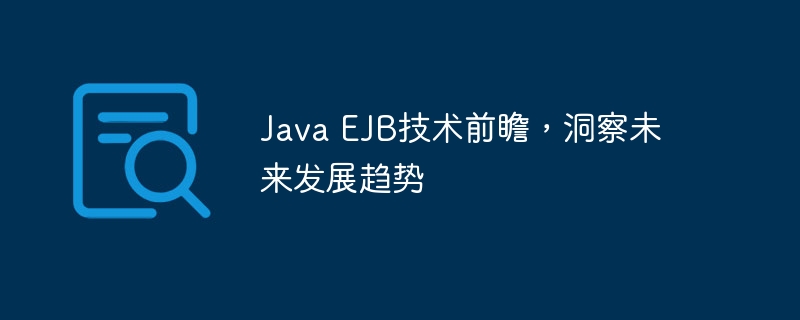

Java EJB technology has always been an important tool for enterprise-level application development. With the continuous evolution of technology, its development prospects have attracted much attention. In this article, PHP editor Yuzai will bring you a forward-looking discussion of Java EJB technology, provide in-depth insights into future development trends, and help you understand the importance and impact of this technology in the field of enterprise applications.
Cloud computingThe popularity of EJB technology has had a significant impact. EJBServercan now be deployed on cloud platforms such as AWS,AzureandGoogle Cloud, which provides scalability, reliability and cost-effectiveness. In addition,Cloud-nativeEJB implementations such as OpenEJB areoptimizedfor cloud environments, with features such as automatic scaling, failover, and continuous integration.
Microservice architecture
The rise of microservicesarchitecturehas posed new challenges to EJB technology. Traditionally, EJB applications have been monolithic, but microservices architecture requires applications to be broken down into smaller independent services. EJB 3.2 introduced stateless beans, which are useful for deploying EJBs in microservices environments. In addition, new microservicesframeworkssuch as Quarkus provide support for EJBs, allowingdevelopersto easily build and deploy microservices-based EJB applications.
Continuous Delivery
Continuous delivery (CI/CD) practices are becoming the standard for EJB development. CI/CD pipelinesAutomatethe build,testand deployment processes, thereby increasing development speed and application quality. EJB technology integrates well with CI/CDtoolsand technologies such asjenkinsandDocker, enabling developers to implement efficient continuous delivery processes.
Demo code
The following is sample code for building a simple EJB microservice using Quarkus:
import javax.ejb.Stateless; @Stateless public class GreetingEJB { public String greet(String name) { return "Hello, " + name + "!"; } }
This EJB class provides a simple greeting method. It uses the@Statelessannotation to indicate that this is a stateless session bean.
Best Practices
To take advantage of future trends in EJB technology, developers can follow the following best practices:
in conclusion
EJB technology is evolving to accommodate the rise of cloud computing, microservices and continuous delivery. By embracing these trends and following best practices, developers can build EJB applications that are robust, flexible, and scalable. As the EJB ecosystem continues to innovate, it is expected that EJB technology will play a vital role in enterprise application development in the future.
The above is the detailed content of Java EJB technology foresight and insight into future development trends. For more information, please follow other related articles on the PHP Chinese website!
 The difference between distributed and microservices
The difference between distributed and microservices What is nfc access control card
What is nfc access control card How to use debug.exe
How to use debug.exe What is the working principle and process of mybatis
What is the working principle and process of mybatis What are the common methods of data collection?
What are the common methods of data collection? js method to delete node
js method to delete node What keys do arrows refer to in computers?
What keys do arrows refer to in computers? What are the operators in Go language?
What are the operators in Go language?



